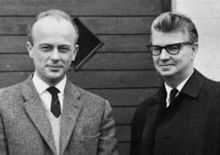Bengt Falck

Bengt Olof Torsten Falck (born Malmö, 16 January 1927) is a Swedish scientist.
He is an emeritus professor at the Faculty of Medicine at Lund University, Sweden. He became Doctor of Medical Science (equiv.: Ph.D.) in 1959, He became an assistant, later associate professor (1960–1970) and full professor of histology in 1970, all at the University of Lund, Sweden. He has published numerous works in the fields of histology, endocrinology and neurobiology.
Research
In his 1959 thesis (Falck, B. Site of production of oestrogen in rat ovary as studied in microtransplants. Acta physiol.scand. Suppl. 163, 1959, 47: 1-101) he was able to show that the production of estrogen in the ovaries is dependant on an interplay of two different hormone producing systems. In one, a precursor - a variant of the male sex hormone - is formed, that is then transformed to estrogen in the second system. His thesis is still well known in scientific circles, which may be noted when Googling ”Falck's two-cell hypothesis of oestrogen synthesis”.
In 1960-61 Falck and Nils-Åke Hillarp developed the Falck-Hillarp fluorescence method.[1]
This technique made it possible to study biologically active substances called monoamines - dopamine, noradrenaline, adrenaline and serotonin – on the cellular level employing fluorescence microscope. Consequently, it was then possible to demonstrate their presence in the central as well as peripheral nervous system. Thereby, it could be established that these monoamines were actually functioning as interneuronal transmitters (signal substances).
The first publication in this field was written by Falck and Alf Torp in 1961 and published in 1962. It is still often quoted in medical and scientific journals. Important follow-up work was published in 1962 by authors Falck, Hillarp, Thieme and Torp. It came to be one of ”The 200 Most-Cited Papers of All Time", SCI 1945–1988”. This was the beginning of an intense neurobiological research which went on for several decades. In April 2012 the symposium ”Från nerv till piller” took place at the University of Lund to celebrate the 50 year jubilee of the first publications on the Falck-Hillarp fluorescence method.
In the 1960s Falck embarked on research of monoamine related substances in epidermal pigment cells (melanocytes) and in malignant melanoma. This led to a new understanding of the construction of the epidermis, and also the discovery of a novel function of the epidermal Langerhans cells. During the end of the 1960s until 2004 much of Falck's epidermal research was emphasized on the Langerhans cells. In 2004 his latest publication ”Mediated exodus of L-Dopa from human epidermal Langerhans cells", was published,
Bengt Falck is the son of Hans Falck (city court judge in Malmö, Sweden) and Maria Hagander. He married Eva Torp in 1951, and together they had four children. In 1994 he married Inger Vestvik.
Bibliography
- Falck, B., and A. Torp. New evidence for the localization of noradrenaline in adrenergic nerve terminals. Med. exp. 1962, 6: 169-172.
- Falck B, Hillarp N-Å, Thieme G & Torp A. Fluorescence of catechol amines and related compounds condensed with formaldehyde. J. Histochem, Cytochem. 10;348-54, 1962.
- Falck B, Bendsoe N, Ronquist G. Mediated exodus of L-dopa from human epidermal Langerhans cells. Amino Acids 2004, 26: 133-138
References
- ↑ Computer Processing of Electron Microscope Images - Page 2 Peter W. Hawkes - 1980 This my view was based on histochemical monoamine research, using the formaldehyde fluorescence (Falck-Hillarp) method developed by Bengt Falck, Nils- Ake Hillarp and collaborators (Falck et al., 1962). With this technique, for the first ...
- Falck, Bengt i Vem är det 1993
- The most-cited papers of all time 1945-1988, part 2. http://www.garfield.library.upenn.edu/essays/v13p227y1990.pdf
- The Falck-Hillarp Method - a revolution in the study of monoamine systems in the CNS. Medicinska fakulteten, Lunds Universitet.